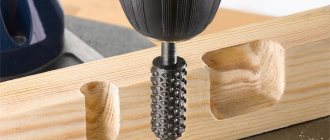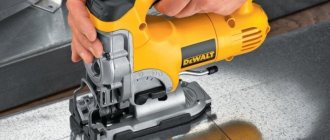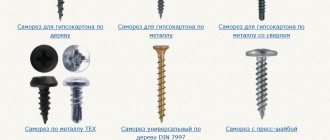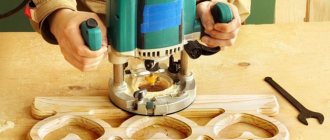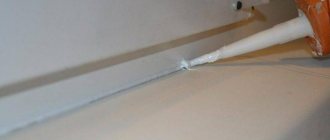Technical features
A jigsaw for wood becomes indispensable when you need to form a complex figure on the surface of plywood, and if you change the blade you can work with metal. Translated from German, the word that has become so familiar to us means a curvilinear trajectory. The design of the tool is simple:
- arcuate frame;
- lever;
- clamps for attaching thin, narrow cutting parts.
The saw blade makes cuts; this is its main functional part. Therefore, how high-quality and sharp the metal strip will be depends on the quality of the work performed. In addition to hand-held devices, there are also jigsaws. They do not replace in any way, but they effectively complement each other.
If you have to cut through a thick, dense piece of wood, use an electric device, but when thin, careful processing is necessary, you cannot do without a hand tool. In addition, it costs less than its electric counterpart, and it is safe to start working with it.
Children's jigsaw
Teachers recommend buying a children's jigsaw for crafts during labor lessons. A convenient tool allows you to make cuts and cut out shaped holes.
Depending on the installed saw, material of different strengths is cut into the frame:
- plastic;
- metal;
- drywall;
- ceramics;
- tree;
- plywood;
- sheets of chipboard or fibreboard.
The master directs the device along the line he needs. It can change direction and process the edges of workpieces thanks to the clearance between the frame and the saw. Figures are cut out both internal and external. The blade is easily removable, which allows you to make cuts of complex configurations. After completing the saw steps, you can:
- replace;
- install;
- thread into a circle;
- continue processing according to the planned scheme.
To solve different problems, jigsaws of different designs are used.
Brief assembly instructions
Today there are two types of jigsaws that you can assemble with your own hands. The first type is manual, and the second is electric. Manual models are considered classics, which is why their description is presented below.
It’s worth saying right away that to assemble a manual jigsaw for wood with your own hands, you will need an old sewing machine, as well as a file. The sequence of work is as follows:
- you need to carefully unscrew the bolts that hold the needle and remove it;
- since the model will be manual, it is necessary to remove the drive shaft;
- it is also necessary to remove the protective model from the machine;
- then expand the hole that holds the needle to such a size that you can insert a file;
- a slight inconvenience will be that you will have to trim the length of the file to the length that the needle had;
- The top and bottom of the product are ground off, after which you can insert it into the machine.
The instructions are quite simple; almost anyone can make a manual jigsaw for wood.
Characteristic features of the tool
Hand jigsaw for wood for schoolchildren
For a novice craftsman, especially if he is a child, it is better to buy a manual jigsaw for wood for a schoolchild in order to gain experience and not break the file.
This is the most fragile part of the tool, which has a different shape and arrangement of teeth. This is how a straight blade with double teeth is used to make cuts in wood and plastic along a straight line. The spiral type of cutting part is used for curved, winding trajectories. Specialists in decorative crafts work with this kind of fabric. The shape of the frame varies:
- rounded;
- pointed;
- rectangular.
This part is made from materials:
- aluminum;
- gland;
- titanium;
- become.
Aluminum frames are not durable. For long-term use, buy tools made of metal alloys. The steel base will withstand the loads exerted by the master’s hand. There are basic factors that should be followed when choosing a tool:
- the shape of the frame determines how long the cut can be made;
- the structure will not break due to the applied efforts, but will spring back thanks to the good raw materials used for production;
- strength is determined by the height of the product; this size should not be greater than the length so that the rigidity of the device does not decrease;
- the methods of fastening the file, the length of the nuts, and the diameter of the thread must be correctly selected in order to securely fix the blade.
When purchasing, pay attention to the design of the clamps. It's good if there is a thumbscrew installed there. Simple nuts will have to be unscrewed by selecting the size of the keys. They take into account the status of the manufacturer, which has become known to the consumer for the quality of its products.
How to choose a manual jigsaw for a schoolchild
When choosing a jigsaw for wood, you need to consider the following parameters:
- type of file;
- canvas size;
- design.
What files exist, which ones are suitable for starting and their classification
There are the following types of files for hand jigsaws:
- Standard or Standard tooth. These files are characterized by teeth that are the same size, distance from each other and direction.
- Reverse or Reverse Skip-tooth. Some of the cutters on the reverse saw are directed upward, which allows you to trim the material during the return movement of the tool. As a result, there are practically no chips on the reverse side.
- Files with missing teeth or Skip-tooth Blades. The absence of cutters eliminates the risk of jigsaw jamming and strong heating of the blade, promotes good removal of sawdust during the work process and increases processing speed.
- Files with double teeth or Double-tooth Blades. The main feature is getting a smooth cut. The file also removes chips well and heats up little.
The blades are distinguished by length, which affects the thickness of the material being processed. According to this parameter, canvas numbers are distinguished from 2.0 to 12.
Beginners, including schoolchildren, should pay attention to the characteristics of the blade when purchasing an instrument. Initially, it is recommended to work with a jigsaw measuring 130 mm, less often - 160 or 165 mm (blades number 3, 5, 7). The sawing thickness is 9.0-12.5 mm. For those who are just starting to saw wood, it is recommended to use saws with a high TPI value. Working with them is slower, but the cut is smoother and more accurate.
Types of models
If you plan to rarely work with woodworking tools, then choose simple models. Among them we can highlight the Stayer Master jigsaw, perfect for schoolchildren. Stainless steel files are durable and reliable. The model is designed for shaped cutting of wood and processing in hard-to-reach places.
Another good model is the Fit school jigsaw 41030. The frame and blade are made of tool steel. The wooden handle provides reliability and ease of grip.
If a student is interested in making products from wood or plywood, then it is recommended to purchase kits for cutting with a jigsaw. They are equipped with additional elements: clamps, stops, guides, etc.
When selecting models, you should pay attention to the manufacturer. You should not buy cheap tools made in China. They are characterized by low strength and short service life.
Design
The manual school jigsaw has a simple design. It consists of a metal frame, handle, file and clamps. The file is attached to the frame using drums or nuts. There is a handle on one side of the frame. It can be made of plastic or wood. The second option is more reliable and durable.
According to the shape of the frame, the tool can be rectangular or pointed. The first option is suitable for straight cutting of the material. The second type is used to create more complex lines.
Jigsaw assembly
A hand-held jigsaw for wood can be turned into a universal one, and can be used to process materials of various properties. To do this, you need to learn how to change the working surface.
Hand jigsaw for wood
If the saw is positioned incorrectly, it will be difficult to work with the workpiece. When installing the actuator, the ends are clamped by 2 mm. from the edges, and the teeth are directed towards the handle. To do this you need to do:
- fix one end of the canvas near the handle;
- compress the arc along the edges, secure the opposite side with other hardware, the emphasis can be placed on a workbench or tabletop;
- After installing the file in the groove, tighten the nut.
Depending on the method of fastening, a wrench or pliers are used if there is not enough strength for manual fixation. When working with a frame in the form of a tubular arc to tension the saw, the base is installed in the grooves. They can be in a table or other device; you need 2 rounded recesses into which a jigsaw is inserted, then tightened.
Types of jigsaws
Formally, the principle of operation of a jigsaw is not far removed from a conventional saw - it is the same tool in which the blade makes reciprocating movements, due to which the cutting occurs. And yet, the purpose of a jigsaw is somewhat different from that of a simple saw.
If a regular saw is not intended for anything other than cutting thick and not very thick lumber, metal, plastic and other elements, then a manual jigsaw is used for finer work. With its help, you won’t be able to saw a 100x100 mm piece of wood, but you can make a shaped cut or saw a very thin sheet of wood without worrying about the quality of the cut.
In the photo - an ordinary manual jigsaw
Since the first appearance of the jigsaw on the market (and this happened back in 1946), manufacturers have been constantly adding useful improvements to its design, so now several types of the same tool can be distinguished:
- manual models are the simplest option. The design of such a jigsaw is extremely simple - a curved metal frame in the lower part of which a thin file is secured with 2 wings. This tool is suitable for small amounts of work;
Note! Using a hand jigsaw, you can make cuts literally with pinpoint precision. So, if you have no experience working with electric models, and the cutting line has a rather complex outline, then it is better to pay attention to manual models.
- jigsaw - in principle, everything is clear from the name; all that remains for a person to do is hold the device and make sure that the blade does not move away from the marked line. The vast majority of modern jigsaws for wood are electric, because due to the large number of vibrations of the blade, cutting takes much less time than using manual models;
Model powered by 220V mains
- It is worth highlighting the category of battery devices separately. They also belong to the group of jigsaws, but due to power from the built-in battery they have high autonomy.
Cordless jigsaw with rotary handle
Manufacturers try to think through the design of a jigsaw down to the smallest detail. For example, it can be connected to a vacuum cleaner so that sawdust does not clog the room; a lamp can be built into the body to illuminate the working surface. The jigsaw can also be equipped with a laser, which is needed to ensure that the file does not deviate from the marked line.
Principle of operation
Hand jigsaw for metal
A manual metal jigsaw means that it can process alloys no thicker than 1 cm.
The strength of the material will not allow working at high speed; the physical strength of the master will not be enough for this. A steel file for such finishing is chosen with a high carbon content in the alloy and fine teeth. But regardless of what work needs to be done, the principle of operation of the jigsaw is the same.
If a worker is sawing a log with a simple saw, the cutting occurs while pushing the tool away from the body of the actor. The jigsaw cuts the object in reverse when the master pulls it towards him. The beginning of creative actions consists, as in any field of production, from preparing the workplace and securing the desired canvas in the frame. Processing is performed in the following order:
- select a workpiece, determine the configuration of the cutting, if necessary, transfer the design diagram onto the surface of the product using carbon paper or fill in the outline with a pencil;
- fix the stand on the workbench or tabletop with clamps, attach the part to it and begin to cut out.
The worker sits comfortably and holds the jigsaw with the handle down. The tool must be in a vertical position and move freely from top to bottom. If the clamps hold the blade tightly, there will be no movement along the cutting line. When it is necessary to change direction to perform a curved pattern configuration, the workpiece is moved, the actuator remains in the same position. To cut an acute angle, saw until the saw begins to turn freely, otherwise the applied force can damage the quality of the design and the blade itself.
When forming patterns, a mark is made in the center of the workpiece, a hook for starting work.
Drill a hole with a small diameter drill, then insert the blade without a frame, after which you attach the base with a handle and begin sawing. The master will distribute the sizes so that chips do not form. Upon completion of work with a jigsaw, the sawed areas are sanded with sandpaper, and the figure is varnished or painted.
Preparing the tool for work
Before starting work, you need to prepare the tool . The quality of the work performed will depend on its preparation. Preparing the jigsaw is carried out in the following sequence:
- The clamps on the top and bottom of the tool are unscrewed.
- The file is inserted into the clamping devices with the teeth down.
- The clamps are tightened to the optimal tension of the file.
When working with a jigsaw, specialists make cuts along a curve, create straight lines, and cut a cutout.
What difficulties arise during work?
The jigsaw requires a lot of patience when working
Such a tool is considered a means of completing tasks for creative people who can spend hours cutting out a technically complex structure. When they begin processing in childhood, they get acquainted with the device, gain experience with exposure in order to obtain as a result a beautiful frame or household item.
Manufacturers have tried to install a comfortable, ergonomic handle, but this still leaves your hands tired from constant tension. There are unwritten rules for preventing fatigue at a later time and obtaining a high-quality cut without breaking the blade:
- The handle is held firmly during vertical movement; the jigsaw must always be in a straight position without angular deviations, then the file will not tear.
- Achieve a neat stitch. This doesn't require much effort. Entry into the structure of the raw material occurs when the canvas moves downwards, which should easily fall under its own weight and slight pressure from the worker’s hand.
- The cutting part is also lifted up freely, friction occurs to a minimum.
- Both hands are equally occupied in the work process. One rotates the part along the curves of the pattern, the other holds the jigsaw without rotating towards the contour.
- The location of the blade should not be in the central part of the figure, but closer to the edges of the cutting line.
- Replaceable cutting inserts do not cut corners. When this cannot be avoided, the work is stopped in order to continue on the other side according to previously made markings, taking into account the necessary vertical or horizontal deviations.
- The file is installed for its intended purpose in accordance with the processing tool and the configuration of the cut. The spiral type is used for curly cuts, straight teeth are needed for the same cuts.
- Poor processing will result if the workpiece is weakly fixed; a reliable clamp is chosen and firmly attached to the work table or stand.
- Keep in mind that the tool is designed to form shaped notches, but this is not a saw, it must be handled with care so as not to constantly change the cutting element to prevent it from breaking under strong pressure. In the work process, efforts are applied with a gradual increase. The guideline is a visual assessment of the chips. It should be small and uniform. When rough grinding appears, change the mode to prevent the formation of unevenness along the edges.
- Avoid sharp turns; to do this, use a drill to create holes, remove the canvas, and insert it into a new structure.
Jigsaw
There are several secrets that figure sawing specialists successfully use.
Despite the complexity of shapes and figures, turns and bends are often repeated, so they concluded:
- An acute angle will be obtained if you bring 2 lines to one point;
- an obtuse or right angle can be made by idle movement of the blade while smoothly turning the workpiece with the second hand;
- to get a curl in the design, increase the speed of the saw together with the rotation of the product;
- beautiful patterns are achieved on thin, sanded plywood even by those who do not yet have experience operating a jigsaw.
Specialists have become very interested in polystyrene sheets. This is a durable multi-colored plastic that lends itself well to processing. Interesting things come out of it.
You need to start practicing with simple diagrams, after all the procedures begin to be carried out automatically, you can begin to more serious drawings. For example, choose the simplest patterns with straight lines, then move on to curves.
There are specific conditions for successful work that must be followed for any amount of work. After every 60 minutes of hard work, you need to take a break and devote at least a quarter of an hour to rest.
What rules will protect against injury?
The mechanism seems harmless and simple only at first glance.
When performing any work, you must follow basic safety rules to avoid injury. There is work to be done
Safety rules when working with a jigsaw
with a sharp, metal part that hurts painfully, and on occasion will reach the bone. Before work, you need to inspect the jigsaw, check that the handle is firmly and firmly secured. If the fastening is broken during creative actions, the handle will fall off, but the hand will continue to move until it comes into contact with the metal pin. Which won't bring anything good.
A workbench or metalworking table must also be equipped with all special devices for safe work. Sometimes even a fall from a simple, unstable chair can cause injury and bone fractures.
The master always tries to take a closer look at his creation. This should not be done during work processes. If you lower your head too low, shavings will get into your eyes.
When a person gets used to a jigsaw and overcomes all the difficult moments, working with it becomes a real passion, and crafts become a source of pride. But a hobby can be combined with a source of income. Manual labor has always been valued much more than mechanical stamping.
- Related Posts
- How to choose a spray gun
- Which electric jigsaw is better to choose - 2021 rating
- Rating of the best manual tile cutters of 2022
« Previous entry
What is a jigsaw?
Figure 1 - What does a jigsaw look like?
The first jigsaws were invented in the mid-16th century.
At that time they had a primitive design, consisting of a U-shaped or U-shaped frame and a working blade.
There was a serious drawback - to work with any material, it was necessary to adjust the voltage manually, which complicated the sawing process.
In modern manual models, the configuration has not changed, but elements responsible for the tension of the file have been added (the first clamping mechanism was patented in 1876).
A jigsaw is a tool for shaped or precise cutting on wood or other material. It is used to make cuts of various complexity in wood, metal, ceramic and composite workpieces. It consists of a metal frame with a fastening clamping system, a handle and a working blade - a file with teeth of various lengths and sizes. The cutting blade moves only in one direction; to change the cutting plane, you need to turn the workpiece or file over.
Important ! The jigsaw has a number of limitations in operation. Using it, it is difficult to make straight straight saws or cut off part of the workpiece at an angle of 90° without a special guide plane.
